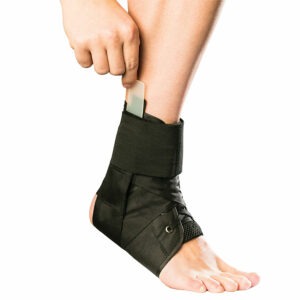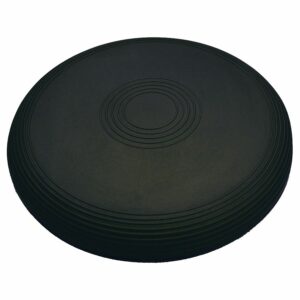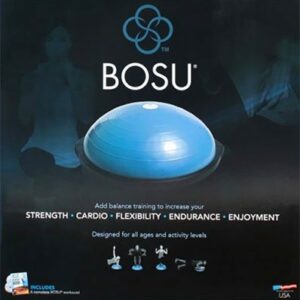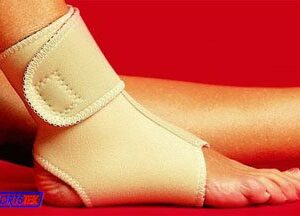Calcaneus Fracture
Updated:
(Also known as Heel Fracture, Calcaneal Fracture, Fractured Calcaneus, Broken Calcaneus)
What is a calcaneus fracture?
A calcaneus fracture is a condition characterized by a break in the heel bone of the foot, known as the calcaneus (figure 1).
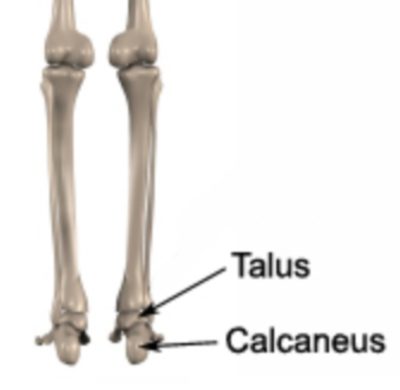
The calcaneus (heel bone) is responsible for transferring weight bearing forces from the ankle to the ground during standing, walking and running activities (figure 1). The calcaneus is situated below the talus and connects with the talus to form the subtalar joint (figure 1). The calcaneus bone also forms joints with several other small bones of the foot including the navicular and cuboid (figure 2).
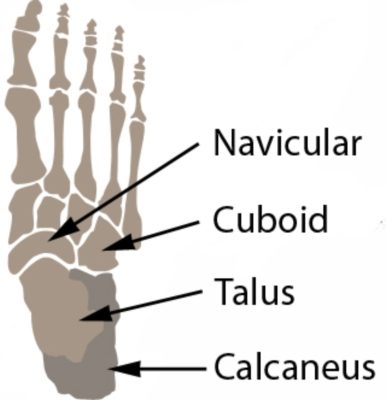
During certain activities, such as landing on the heel bone from a height, or when rolling an ankle, stress is placed on the calcaneus bone. When this stress is traumatic, and beyond what the bone can withstand, a break in the calcaneus may occur. This condition is known as a calcaneus fracture.
Because of the large forces required to break the calcaneus bone, this condition often occurs in combination with other injuries such as a sprained ankle or other fractures of the foot, ankle or lower leg.
Calcaneus fractures can vary in location, severity and type including stress fracture, displaced fracture, un-displaced fracture, comminuted fracture etc.
Causes of a calcaneus fracture
A calcaneus fracture typically occurs due to traumatic weight bearing forces such as a landing on the heel bone from a height. Occasionally it may also occur in association with a rolled ankle particularly with significant weight bearing forces. A stress fracture to the calcaneus may occur as a result of overuse often associated from a recent increase or high volume of running or marching activity.
Signs and symptoms of a calcaneus fracture
Patients with a calcaneus fracture typically experience a sudden onset of sharp, intense heel pain at the time of injury. This often causes the patient to limp or attempt to walk without placing weight on the heel so as to protect the calcaneus. In severe cases, particularly involving a displaced fracture of the calcaneus, patients may be unable to weight bear. Pain is usually felt in the heel region although symptoms may be felt in the sides or occasionally the front of the ankle. Symptoms may settle quickly with rest leaving patients with an ache at the site of injury that is particularly prominent at night or first thing in the morning.
Patients with a calcaneus fracture may also experience swelling, bruising and pain on firmly touching the affected region of bone. Squeezing of the heel bone is also usually quite painful. Pain may increase during certain movements of the foot or ankle, when standing or walking (particularly on uneven surfaces), when placing weight through the heel, putting shoes on or when attempting to stand or walk. Occasionally patients may also experience pins and needles or numbness in the ankle, foot or toes.
Diagnosis of a calcaneus fracture
A thorough subjective and objective examination from a physiotherapist is essential to assist with diagnosis of a calcaneus fracture. An X-ray is usually required to confirm diagnosis and assess the severity. Further investigations such as an MRI, CT scan or bone scan may be required, in some cases, to assist with diagnosis and assess the severity of the injury.
Treatment for a calcaneus fracture
For those calcaneus fractures that are displaced, treatment typically involves anatomical reduction (i.e. re-alignment of the fracture by careful manipulation under anesthetic) followed by surgical internal fixation to stabilize the fracture (e.g. use of screws). Surgery may be followed by the use of a protective boot, brace, plaster cast and/or crutches for a number of weeks.
For those calcaneus fractures that are not displaced, treatment may involve the use of crutches and/or a protective boot or brace, or, plaster cast immobilization and the use of crutches, followed by the use of a protective boot or brace for a number of weeks. The orthopedic specialist will advise the patient as to which management is most appropriate based on a number of factors, including the type, location and severity of the fracture.
Evaluation of the fracture with follow up X-rays, or CT scan, is important to ensure the fracture is healing in an ideal position. Once healing is confirmed, rehabilitation can progress as guided by the treating physiotherapist.
One of the most important components of rehabilitation following a calcaneus fracture is that the patient rests sufficiently from any activity that increases their pain (crutches and / or a protective boot are often required). Activities which place large amounts of stress through the calcaneus should also be avoided, particularly excessive weight bearing activity such as running, jumping, marching, standing or walking excessively (especially on uneven surfaces). Rest from aggravating activities allows the healing process to take place in the absence of further damage. Once the patient can perform these activities pain free, a gradual return to these activities and weight bearing forces is indicated provided there is no increase in symptoms. This should take place over a period of weeks to months with direction from the treating physiotherapist.
Ignoring symptoms or adopting a ‘no pain, no gain’ attitude is likely to cause further damage and may slow healing or prevent healing of the calcaneus fracture altogether.
Patients with a fractured calcaneus should perform pain-free flexibility, strengthening and balance exercises as part of their rehabilitation to ensure an optimal outcome. This is particularly important, as balance, soft tissue flexibility and strength are quickly lost with inactivity. Hydrotherapy exercises may also be indicated. The treating physiotherapist can advise which exercises are most appropriate for the patient and when they should be commenced.
In the final stages of rehabilitation for a calcaneus fracture, a gradual return to activity or sport can occur as guided by the treating physiotherapist provided there is no increase in symptoms.
It may be advised upon returning to some sports, particularly those sports requiring rapid change of direction, such as football and netball, that the ankle is either taped or braced for additional support or protection. The treating physiotherapist can advise if this is recommended.
Prognosis of a calcaneus fracture
Patients with a fractured calcaneus usually make a full recovery with appropriate management (whether surgical or conservative). Return to activity or sport can usually take place in a number of weeks to many months and should be guided by the treating physiotherapist and specialist. In patients with severe injuries involving damage to other bones, soft tissue, nerves or blood vessels, recovery time may be significantly prolonged.
Physiotherapy for a calcaneus fracture
Physiotherapy treatment is vital in all patients with a calcaneus fracture to hasten healing and ensure an optimal outcome. Treatment may comprise:
- soft tissue massage
- joint mobilization
- electrotherapy (e.g. ultrasound)
- taping or bracing
- the use of a protective boot or brace
- the use of crutches
- exercises to improve strength, flexibility and balance
- hydrotherapy
- education
- activity modification
- a graduated return to activity plan
- footwear advice
Other intervention for a calcaneus fracture
Despite appropriate physiotherapy management, some patients with a calcaneus fracture do not improve adequately and may require other intervention. The treating physiotherapist or doctor can advise on the best course of management when this is the case. This may include further investigations such as X-rays, CT scan, MRI or bone scan, periods of plaster cast immobilization or referral to appropriate medical authorities who can advise on any intervention that may be appropriate to improve the fractured calcaneus. Occasionally, patients with fractures that are initially managed without surgical intervention may require surgery to promote healing and stabilize the fracture. This may involve internal fixation, surgical removal of loose fragments, bone drilling or use of a bone graft to aid fracture healing.
Exercises for a calcaneus fracture
The following exercises are commonly prescribed to patients with a calcaneus fracture following confirmation that the fracture has healed or that pain free mobilization can commence as directed by the surgeon. You should discuss the suitability of these exercises with your physiotherapist prior to beginning them. Generally, they should be performed 3 times daily and only provided they do not cause or increase symptoms.
Foot and Ankle Up and Down
Move your foot and ankle up and down as far as possible and comfortable without pain (figure 3). Repeat 10 – 20 times provided there is no increase in symptoms.
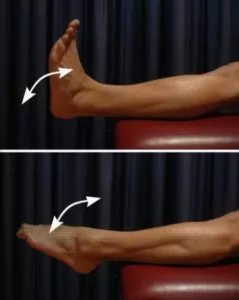
Foot and Ankle In and Out
Move your foot and ankle in and out as far as possible and comfortable without pain (figure 4). Repeat 10 – 20 times provided there is no increase in symptoms.
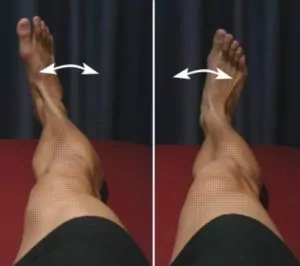
Foot and ankle circles
Move your foot and ankle in a circle as large as possible and comfortable without pain (figure 5). Repeat 10 times in each direction provided there is no increase in symptoms.
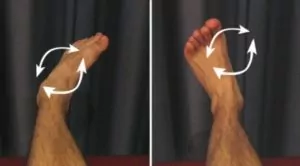
Physiotherapy products for a calcaneus fracture
Some of the most commonly recommended products by physiotherapist to hasten healing and speed recovery in patients with a calcaneus fracture include:
To purchase physiotherapy products for a calcaneus fracture click on one of the above links or visit the PhysioAdvisor Shop.
Other Exercses
- View more Ankle Stretches.
- View Ankle Strengthening Exercises.
- View Balance Exercises.
Find a Physio for a calcaneus fracture
Find a Physiotherapist in your local area who can treat a calcaneus fracture.

Link to this Page
If you would like to link to this article on your website, simply copy the code below and add it to your page:
<a href="https://physioadvisor.com.au/injuries/foot/calcaneus-fracture”>Calcaneus Fracture – PhysioAdvisor.com</a><br/>PhysioAdvisor offers detailed physiotherapy information on a calcaneal fracture including: causes, symptoms, diagnosis, treatment, exercises, physiotherapy products and more...
Return to the top of Calcaneus Fracture.

